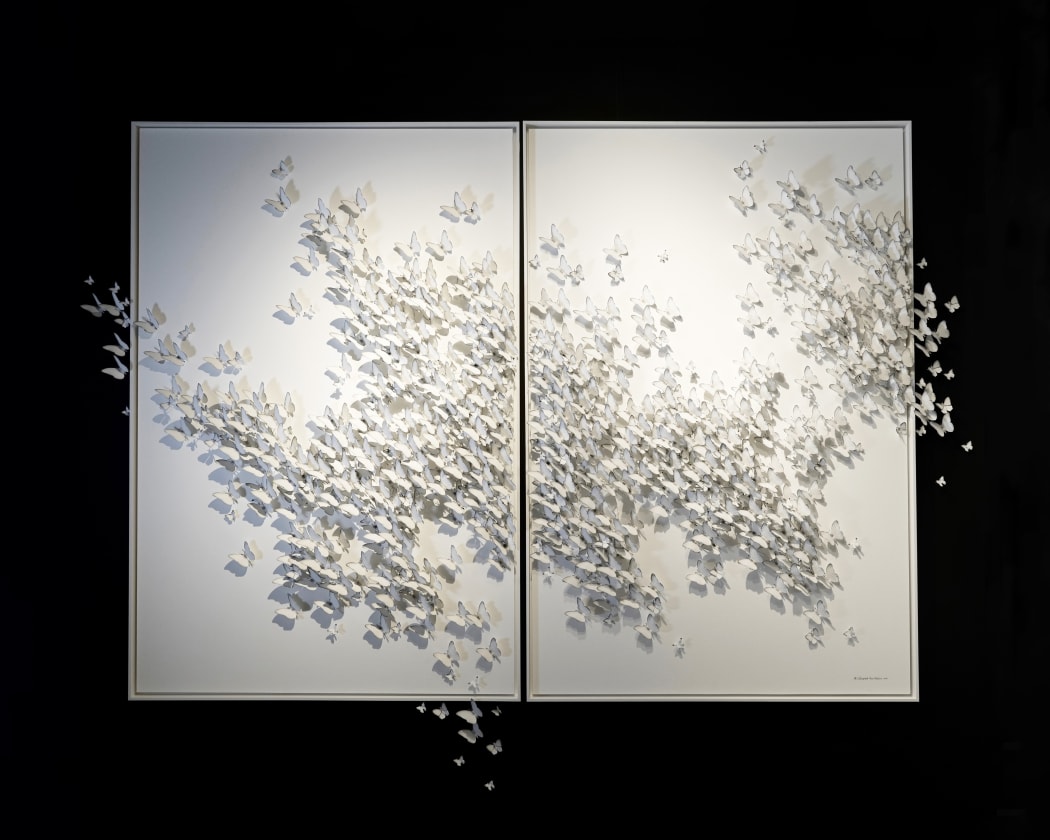
Spring is in full swing, the 60th Venice Biennale has opened with many exciting news, and the time is ripe to look more closely at fine art trends in 2024. This year promises to bring interesting and intriguing movements to the contemporary art scene. Join us as we explore some of the defining trends that will shape the artistic discourse in the year ahead.
Nature and Environmental Justice
Consider Julien Creuzet’s installation for the 2024 French Pavilion in Venice: “The sight of the matoutou falaise is a gift when it appears in dense forests, on the bark of the Zamana trees or the rocks of the Martinique shores. It requires a deep connection to the environment…” (La Biennale) – just one of many examples of works that bring themes of nature into exhibition spaces.
Indeed, contemporary artists increasingly confront pressing issues of sustainability, climate change, and environmental stewardship, not only inconceptual and theoretical terms but also through tangible, practical interventions, often reflected in their choice of materials and methods.
Delcy Morelos, Athena LaTocha, Precious Okoyomon, and Umico Niwa are only a few of many great examples of artists engaging with themes of land, environment, colonization and cultural reclamation, prompting the public to reconsider their relationship with the planet and the legacies we leave behind.
AI and Technology
The rise of AI-powered art has sparked controversy regarding its potential impact on the arts and creativity, both promising and threatening. While many artists highlight the limitations inherent in non-human, technological creativity, countless others embrace and explore the expansive opportunities afforded by AI technologies.
Such explorations not only challenge the limits of creativity and technology but also delve into inquiry into what Polish artist Agnieska Kurant aptly describes as “work that is about the collective unconscious, is about what is possible of what we don’t know.” Where it will take us and what possibilities we might discover along the way remains to be seen.
Rising Visibility of Indigenous Artists
This year's Venice Biennale shines a spotlight on Indigenous artists, placing them firmly at the forefront of the global art stage. Among these luminaries, we find Native American Jeffrey Gibson representing the United States, Kalaalleq-Greenlandic artist Inuuteq Storch representing Denmark, and Aboriginal artist Archie Moore making history by winning Australia its inaugural Golden Lion with his work titled kith and kin.
Additionally, we celebrate the contributions of Indigenous women artists from the United States and Canada, including:
-
Jaune Quick-to-See Smith
-
Wendy Red Star
-
Dana Claxton
-
Tanya Lukin Linklater
-
Meryl McMaster
-
Caroline Monnet
This gathering of talent promises to further center a rich variety of First Nations masters and emerging stars, poised to captivate the international art community. Excited about the overdue recognition and growing prominence of Indigenous artists, Erin Christovale, curator at the Hammer Museum, told Artsy: “I’m looking forward to more specificity and scholarship on the traditions, politics, and practices of such a wide-ranging group of artists.”
Textile, Ceramics and Other Materials
A strong presence of textile arts has been observed at art fairs and biennials worldwide, sparking excitement about the creative possibilities of one of the oldest materials artists and artisans have worked with. Katherine Jentleson of the High Museum of Art in Atlanta notes:
“Though a revival of textile-infused practices is present among artists from many backgrounds, it is especially abundant among Black artists as seen in recent gallery shows:of Sanford Biggers (at Monique Meloche), Eric N. Mack (at Paula Cooper Gallery), Chris Meyers (at James Cohan), Bisa Butler (at Jeffrey Deitch), Michael A. Cummings (at Hunter Dunbar Projects), and Dawn Williams Boyd, Myrlande Constant, and Yvonne Wells (all at Fort Gansevoort).”
Similarly, artists have been exploring the possibilities and limits of ceramics, taking it to new dimensions. For example, we’re thinking of:
-
Simone Leigh
-
Raven Halfmoon
-
Cathy Lu
-
Ruby Neri
-
Julia Haft-Candell
-
Rose B. Simpson
-
Genesis Belanger
And might glass be the next hot material? Amy Smith-Stewart, chief curator at the Aldrich Contemporary Art Museum, points us to the following artists who explore glass in their work:
-
Dyani White Hawk
-
Esther Ruiz
-
Chiffon Thomas
-
Layo Bright
-
Ragen Moss
-
Hannah Levy
This overview of some of the trends defining the art landscape in 2024 reflect a dynamic interplay between tradition and innovation. From the deep exploration of nature and environmental justice to the evolving dialogue surrounding AI and technology, and the burgeoning visibility of Indigenous artists on the global stage, each trend offers a unique lens through which to examine contemporary artistic expression.
Additionally, the resurgence of interest in traditional materials like textiles, ceramics, and glass for artistic exploration underscore the enduring power of materiality in shaping artistic discourse. As we navigate these diverse currents of creativity, we are reminded of the art world's boundless capacity for reinvention and renewal, inviting us to engage with the evolving landscape of human expression in all its richness and complexity.
